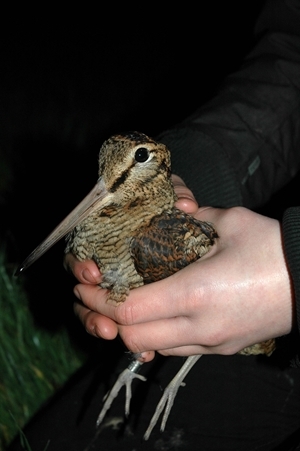 For the first time British scientists have proved that migrating woodcock from the UK are travelling enormous distances to breed. It is estimated that one particular woodcock called ‘Monkey’ has travelled at least 39,000 km in the course of his short life time.
For the first time British scientists have proved that migrating woodcock from the UK are travelling enormous distances to breed. It is estimated that one particular woodcock called ‘Monkey’ has travelled at least 39,000 km in the course of his short life time.
This incredible revelation has been made possible through the use of tiny satellite transmitters attached to migrating woodcock by scientists from the Game & Wildlife Conservation Trust (GWCT) who have tracked the migration routes of 24 woodcock wintering in Britain and Ireland using this state-of-the-art technology. The birds tagged this spring came from regions across the country including west Wales, Cornwall, south-west Ireland, Norfolk and Scotland.
‘Monkey’, tagged as an adult bird (at least two years old) in Cornwall last year, has now just completed at least his third spring migration.
The scientists have discovered that following his over-winter stay in Britain, ‘Monkey’ has returned to exactly the same breeding ground in Siberia in the last two springs, where he was probably hatched. This is an extraordinary feat for such a small bird and the distances he has travelled to Siberia to breed and then back to Cornwall to spend the winter, most likely over at least three years is impressive.
Dr Andrew Hoodless who leads this unique research on woodcock migration explains, “This state of the art technology is a dream-come-true because for the first time, we are able to understand some of the mysteries surrounding this elusive bird. Being able to watch these birds ‘live’ through satellite technology is helping us to piece together an accurate picture of where these birds go to breed, their stop-over locations and how far they can travel in one flight. The speed and distances of their migrations is astounding and it is sometimes quite heart-stopping to watch their perilous journeys as they get blown off course or delayed by bad weather.”
But ‘Monkey’, the current record-holder has a younger contender following in his flight-path. ‘Crugith’, a female known to be two-years old, who was tagged in Cornwall earlier this spring, has already caught up with the more experienced Monkey in Siberia and is now preparing to breed.
Andrew Hoodless, explains, “The data we are receiving from our satellite-tagged birds shows that they are returning to the same breeding grounds, year after year. This is the first confirmed evidence that woodcock are faithful to their breeding sites in Russia and Eastern Europe as well as their over-wintering grounds in Britain.”
Although sixteen birds have arrived safely on their breeding grounds across Europe, two birds called ‘Busy’, tagged in Cornwall in February 2012, and ‘Moc’, tagged in west Wales this spring, have gone missing.
Andrew Hoodless says, “We have not received a signal from ‘Moc’ for some time. His last known position was near Horning, north of Norwich and it is likely that he has died. Should anyone come across the satellite tag it would be really valuable to have this returned. We know that ‘Busy’ was predated by a sparrowhawk near Andover, because the event was witnessed by a member of the public who kindly returned the tag.”
The woodcock’s status as a breeding bird in the UK is causing concern among some conservationists, Dr Hoodless says, “Our unique research is important because the woodcock is amber listed as a species of conservation concern owing to a decline in breeding numbers of about 86 per cent in the UK over the last 30 years. Across Europe its status is poorly documented. Compared to many birds we know very little about its behaviour and ecology because of its secretive nature. The information we gather through the satellite-tracking will help inform international conservation policies for woodcock in the future.”
To view the incredible migration flights of the satellite-tracked birds and follow their latest movements, visit the GWCT’s dedicated website at www.woodcockwatch.com
The GWCT is looking for people to sponsor a satellite-tracked woodcock for £36 a year, which will cover the cost of downloading data from satellites for a bird on one day every month. The progress of each bird can be checked daily. To sponsor a bird email: woodcock@gwct.org.uk or telephone: 01425 652381.
END
Photocaption: Scientists from the Game & Wildlife Conservation Trust have proved that migrating woodcock from the UK are travelling enormous distances to breed. ' Monkey' who was satellite tagged in Cornwall two years ago has travelled at least 39,000 km in his life-time.
Notes to editors
The Game & Wildlife Conservation Trust – providing research-led conservation for a thriving countryside. The GWCT is an independent wildlife conservation charity which has carried out scientific research into Britain’s game and wildlife since the 1930s. We advise farmers and landowners on improving wildlife habitats. We employ more than 60 post-doctoral scientists and other research staff with expertise in areas such as birds, insects, mammals, farming, fish and statistics. We undertake our own research as well as projects funded by contract and grant-aid from government and private bodies.
For information, contact:
Eleanor Williams
Telephone: 07592 025476
Email: press@gwct.org.uk